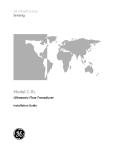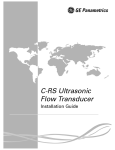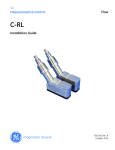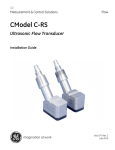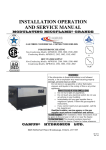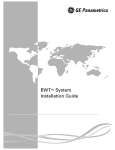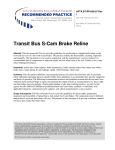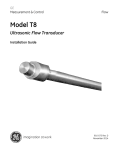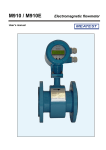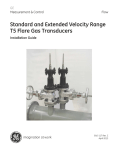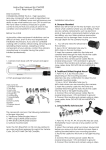Download Model C-RV - GE Measurement & Control
Transcript
GE Infrastructure Sensing Model C-RV Ultrasonic Flow Transducer Installation Guide GE Infrastructure Sensing Model C-RV Ultrasonic Flow Transducer Installation Guide 916-078A October 2004 October 2004 Table of Contents Introduction . . . . . . . . . . . . . . . . . . . . . . . . . . . . . . . . . . . . . . . . . . . . . . . . . . . . . . . . . . . . . . . . . . . . . . . . . . . . . . . . . 1 Transducer Construction . . . . . . . . . . . . . . . . . . . . . . . . . . . . . . . . . . . . . . . . . . . . . . . . . . . . . . . . . . . . . . . . . . . . . 1 Dampening Material . . . . . . . . . . . . . . . . . . . . . . . . . . . . . . . . . . . . . . . . . . . . . . . . . . . . . . . . . . . . . . . . . . . . . . . . . 2 Installing the C-RV Transducers . . . . . . . . . . . . . . . . . . . . . . . . . . . . . . . . . . . . . . . . . . . . . . . . . . . . . . . . . . . . . . . 3 Choosing an Installation Location . . . . . . . . . . . . . . . . . . . . . . . . . . . . . . . . . . . . . . . . . . . . . . . . . . . . . . . . . 4 Obtaining the Transducer Spacing . . . . . . . . . . . . . . . . . . . . . . . . . . . . . . . . . . . . . . . . . . . . . . . . . . . . . . . . 5 Installing the V Series Clamping Fixtures and Transducers. . . . . . . . . . . . . . . . . . . . . . . . . . . . . . . . . . 6 Tools and Equipment Needed . . . . . . . . . . . . . . . . . . . . . . . . . . . . . . . . . . . . . . . . . . . . . . . . . . . . . . . . . 6 Setting the Transducer Spacing . . . . . . . . . . . . . . . . . . . . . . . . . . . . . . . . . . . . . . . . . . . . . . . . . . . . . . . 7 Installing the Fixture . . . . . . . . . . . . . . . . . . . . . . . . . . . . . . . . . . . . . . . . . . . . . . . . . . . . . . . . . . . . . . . . . 9 Preparing the Pipe . . . . . . . . . . . . . . . . . . . . . . . . . . . . . . . . . . . . . . . . . . . . . . . . . . . . . . . . . . . . . . . . . . 12 Applying the DMP-1 Dampening Material . . . . . . . . . . . . . . . . . . . . . . . . . . . . . . . . . . . . . . . . . . . . 14 Applying DMP-3 Compound . . . . . . . . . . . . . . . . . . . . . . . . . . . . . . . . . . . . . . . . . . . . . . . . . . . . . . . . . 16 Applying the Pipe Dampening Jacket - PDJ . . . . . . . . . . . . . . . . . . . . . . . . . . . . . . . . . . . . . . . . . . . 18 Mounting the Transducers . . . . . . . . . . . . . . . . . . . . . . . . . . . . . . . . . . . . . . . . . . . . . . . . . . . . . . . . . . . 20 Maintenance. . . . . . . . . . . . . . . . . . . . . . . . . . . . . . . . . . . . . . . . . . . . . . . . . . . . . . . . . . . . . . . . . . . . . . . . . . . . . . . . 23 Specifications. . . . . . . . . . . . . . . . . . . . . . . . . . . . . . . . . . . . . . . . . . . . . . . . . . . . . . . . . . . . . . . . . . . . . . . . . . . . . . . 24 iii October 2004 Warranty Each instrument manufactured by GE Infrastructure Sensing, Inc. is warranted to be free from defects in material and workmanship. Liability under this warranty is limited to restoring the instrument to normal operation or replacing the instrument, at the sole discretion of GE Infrastructure Sensing, Inc. Fuses and batteries are specifically excluded from any liability. This warranty is effective from the date of delivery to the original purchaser. If GE Infrastructure Sensing, Inc. determines that the equipment was defective, the warranty period is: • one year for general electronic failures of the instrument • one year for mechanical failures of the sensor If GE Infrastructure Sensing, Inc. determines that the equipment was damaged by misuse, improper installation, the use of unauthorized replacement parts, or operating conditions outside the guidelines specified by GE Infrastructure Sensing, Inc., the repairs are not covered under this warranty. The warranties set forth herein are exclusive and are in lieu of all other warranties whether statutory, express or implied (including warranties of merchantability and fitness for a particular purpose, and warranties arising from course of dealing or usage or trade). Return Policy If a GE Infrastructure Sensing, Inc. instrument malfunctions within the warranty period, the following procedure must be completed: Notify GE Infrastructure Sensing, Inc., giving full details of the problem, and provide the model number and serial number of the instrument. If the nature of the problem indicates the need for factory service, GE Infrastructure Sensing, Inc. will issue a RETURN AUTHORIZATION number (RA), and shipping instructions for the return of the instrument to a service center will be provided. If GE Infrastructure Sensing, Inc. instructs you to send your instrument to a service center, it must be shipped prepaid to the authorized repair station indicated in the shipping instructions. Upon receipt, GE Infrastructure Sensing, Inc. will evaluate the instrument to determine the cause of the malfunction. Then, one of the following courses of action will then be taken: • If the damage is covered under the terms of the warranty, the instrument will be repaired at no cost to the owner and returned. • If GE Infrastructure Sensing, Inc. determines that the damage is not covered under the terms of the warranty, or if the warranty has expired, an estimate for the cost of the repairs at standard rates will be provided. Upon receipt of the owner’s approval to proceed, the instrument will be repaired and returned. 1. 2. 3. iv October 2004 Introduction Transducer Construction The C-RV clamp-on ultrasonic flow transducers are used exclusively with the GE Infrastructure Sensing line of ultrasonic flowmeters. These transducers are used to measure the flow of various gases through pipes having diameters from less than 2 in. (50 mm) to 12 in. (300 mm). Such measurements are independent of the pipe material. This document provides details on the following topics: • Transducer Construction • Dampening Material • Installation • Maintenance • Specifications A transducer assembly includes a 316 stainless steel housing with a plastic wedge attached and a BNC type electrical connector. The transducer features integral 3/4” NPT-M threads for mounting a junction box and integral 5/8-24 threads for mounting a submersible connector if desired, see Figure 1 below. Figure 1: Transducer Assembly (ref dwg 536-023) C-RV Ultrasonic Flow Transducers Installation Guide 1 October 2004 Dampening Material GE Infrastructure Sensing strongly recommends applying DMP dampening material in all permanent clamp-on applications to help eliminate noise. The following dampening materials are available: • The DMP-1 self-adhesive sheet for applications up to 200°F (93°C). The material comes as two 9.5-in. (24 cm) wide sheets cut in sufficient length for your application. (Length ≈ twice the circumference of the pipe at the installation site.) • The DMP-3 is a compound for applications over 150°F (65oC). The compound is applied to the pipe with a putty knife. • Pipe Dampening Jacket (PDJ) is a sheath/jacket with DMP-3 pre-applied to the inside and is also used for applications over 150oF (65oC). The PDJ is available for pipes 4”, 6”, 8”, 10” and 12” (100, 150, 200, 250 and 300 mm) in diameter. At a minimum, you should consider applying dampening material if you have any of the following conditions: • The distance from the nearest butt weld or pipe flange is less than 10 ft (3 m). • The pipe size is under 16 in. (400 mm) diameter and the gas pressure is 200 psig (1,378 kPa) or lower. • The pipe is deformed (non-circular). • The pipe is old, with a history of scaling or rust. • The pipe experiences constant condensation on the outside. Note: Consult a GE Infrastructure Sensing flowmeter applications engineer or sales engineer if you have any questions regarding dampening material. Details for properly installing the dampening material are discussed in the installation instructions. 2 C-RV Ultrasonic Flow Transducers Installation Guide October 2004 Installing the C-RV Transducers GE Infrastructure Sensing offers the following fixtures to suit your applications needs: • V4 clamping fixture • V8 clamping fixture • V12 clamping fixture Figure 2 (below) shows the V4, V8 and V12 fixture assemblies. Each type of transducer and fixture requires the installation of dampening material for acoustic isolation. Complete the steps in the following sections to position and install the transducers, fixtures and dampening material. V8 Fixture V4 Fixture V12 Fixture Figure 2: The V4, V8 and V12 Fixtures C-RV Ultrasonic Flow Transducers Installation Guide 3 October 2004 Choosing an Installation Location 1. Locate the transducer measurement point at least 3 ft (1 m) from any butt welds or flanges, ideally in the center of a 20 ft (6 m) length of straight run of pipe. Keep appropriate clearance on either side of the pipe for easy transducer installation: • 6 in. (15 cm) if you are not using a junction box, or • 9 in. (23 cm) if you are using a junction box. Note: To guarantee the specified accuracy of the flowmeter there is no substitute for straight run and fully-developed flow profile. However, if straight run is not available, the transducer location should be in a position such that the acoustic signal travels through the full distribution of the under-developed flow profile for best repeatability. 2. Place the transducers as close as possible to the horizontal plane. Locate the transducers on opposite sides of the pipe 180o apart, ideally at the 3 and 9 o’clock positions. Do not place transducers on the top or bottom of the pipe. Pipe Transducer Signal Path End View 4 C-RV Ultrasonic Flow Transducers Installation Guide October 2004 Obtaining the Transducer Spacing Enter the required information into the flowmeter’s user program (Pipe Parameters menu) to determine the transducer spacing. Some applications may require you to conduct a pipe survey before you can obtain the transducer spacing. Refer to Obtaining the Transducer Spacing section of your User’s Manual or Startup Guide for more details. IMPORTANT: To maintain ATEX certification the transducer face must be protected against impact. This is provided by properly installing the transducer into the clamping fixture. All care must be provided during installation to ensure all protection is afforded. C-RV Ultrasonic Flow Transducers Installation Guide 5 October 2004 Installing the V Series Clamping Fixtures and Transducers Installing the V Series clamping fixture and transducers requires the following steps: • Setting the Transducer Spacing • Installing the Fixture • Preparing the Pipe • Applying the Dampening Material • Mounting the Transducers Refer to the following section to properly prepare for installation Tools and Equipment Needed Installing the fixture and transducers requires various tools. You will also need additional tools to apply the dampening material. Refer to Table 1 below for a complete list of everything you will need. Table 1: Tools for V Series Fixture Installation Fixture and Transducers • • • • • • • • straight edge ruler/scale • • thread sealant (for junction boxes only) • 1 in. crescent/box wrench or 10 in. adjustable wrench • other safety equipment suitable for your application permanent marker sandpaper file emery cloth ultrasonic thickness gage tape measure dry towel or rag 7/16 in. crescent/box wrench or 4 in. adjustable wrench DMP-1 • 6 utility knife DMP-3 • • gloves putty knife or other utensil to remove access dampening compound PDJ • 7/16 in. crescent/ box wrench or 4 in. adjustable wrench C-RV Ultrasonic Flow Transducers Installation Guide October 2004 Setting the Transducer Spacing 1. If necessary, assemble the fixture as shown below. Make sure the zero points on each ruler are at the same end of the fixture as shown below. Insert in 4 places Top View Zero Points 2. Using a ruler (or the ruler printed on the fixture), set one of the mounting blocks at least 1 in. (2.5 cm) from the edge of the fixture. To move the block, loosen the set screw, slide the block to the desired location and tighten the set screw. Use the edge of the block shown below as the setting point. Zero Point on Measuring Scales Mounting Block Set at 1 in. (2.5 cm) Set Screw Set at 1 in. (2.5cm) using this edge of block Top View C-RV Ultrasonic Flow Transducers Installation Guide 7 October 2004 Setting the Transducer Spacing (cont.) 3. Slide the other mounting block to the calculated spacing plus 1 in. (2.5 cm). For example: a. Spacing for the first mounting block = 1 in. (2.5 cm) b. Spacing as calculated by the flowmeter = 0.5 in. (12.5 mm) c. Second mounting block final location = 1 in. + 0.5 in. = 1.5 in. (2.5 cm + 1.25 cm = 3.75 cm) The overall spacing between blocks should be left edge to left edge, or right edge to right edge. Note: If possible, the second block should also be set at least 1 in. (2.5 cm) from the edge of the fixture. Zero Point on Set second block Measuring Scales using this edge S Top View 8 C-RV Ultrasonic Flow Transducers Installation Guide October 2004 Installing the Fixture During this procedure you will be required to place the fixture and transducers on the pipe more than once, and in some cases, as many as 3 times. The fixture and transducers are placed on the pipe temporarily for two purposes: • to mark where the fixture and transducers make contact with the pipe so those sections can be cleaned; and, • as a reference for placing the dampening material. Use the steps below to begin installation: 1. Remove any pipe insulation from the installation site. Note: Make sure you clear an area that is large enough for the transducers and dampening material installation. 2. Disassemble the fixture by removing the four nuts from the threaded rods and pulling apart the two halves of the fixture. Note: Make note of the assembled fixture to make sure you reassemble it the same way. Otherwise, the transducer spacing will be incorrect. Remove 4 places Top View C-RV Ultrasonic Flow Transducers Installation Guide 9 October 2004 Installing the Fixture (cont.) 3. Position the clamping fixture as close as possible to the horizontal plane. The fixture should be positioned so the transducers will be located on the opposite sides of the pipe 180o apart, ideally at the 3 and 9 o’clock positions. For best profile identification in limited straight run, place transducers at 1 and 7 o’clock. Do not place fixture on the pipe so the transducers are the top or bottom of the pipe Note: Make sure you reassemble the fixture properly to ensure the correct transducer spacing. If the fixture has rulers on the rails, make sure the zero points on each ruler are at the same end of the fixture as shown below. Mating Half Top View Zero on Each Measuring Scales Top View 10 C-RV Ultrasonic Flow Transducers Installation Guide October 2004 Installing the Fixture (cont.) 4. Install the four nuts onto the threaded rods with the convex side of the nut facing the fixture. Hand tighten each nut evenly as shown below. DO NOT use a cross-tightening pattern. Nuts Nuts (2 places) (2 places) Top View Tightening Pattern of Bolts Tighten equally first C-RV Ultrasonic Flow Transducers Installation Guide Tighten equally second 2 3 1 4 Side View 11 October 2004 Preparing the Pipe 1. Using a permanent marker, mark the inside edges of the fixture. These lines indicate where to clean the pipe and then apply the dampening material. Make sure you mark both sides of the fixture. Make marks here and here Top View 2. Remove the fixture. Marks Top View 12 C-RV Ultrasonic Flow Transducers Installation Guide October 2004 Preparing the Pipe (cont.) 3. Clean the area between the marks. Remove any loose paint or rust with sandpaper or emery cloth. Make sure to preserve the original curvature of the pipe. If the finish is mirror-smooth, use the file to roughen the surface. TIP: If you are concerned about removing the reference lines during cleaning, use a tape measure and measure 2 ft (60 cm) from one of the reference lines and mark another line (temporary or permanent). This line can be used as a reference point later. 4. Using an emery cloth, clean the cleared area. Again, take care to preserve the original curvature of the pipe. 5. With an ultrasonic thickness gage, measure the pipe thickness at a minimum of six spots on the cleared area. Take at least three measurements at each spot and average the results to ensure accuracy. The thickness should not vary by more than 5% among the six spots. If you encounter more than a 5% variation, move to another section of the pipe. Verify that the wall thickness at both transducer locations has less than the 5% variation. What’s Next? The next series of steps depends on what type of dampening material you are using. If you are using: • DMP-1, proceed to the next section on the next page. • DMP-3, proceed to page 16. • PDJ, proceed to page 18. C-RV Ultrasonic Flow Transducers Installation Guide 13 October 2004 Applying the DMP-1 Dampening Material 1. Unroll the DMP-1 material and peel back a small part of the paper backing. Do not completely remove the paper backing. One 9.5-in. (24-cm) roll fits between the lines marked on the pipe. 2. Use a dry towel or rag and dry the pipe. IMPORTANT: The dampening material will only adhere to the pipe correctly if the pipe is completely dry. 3. Roll the DMP-1 dampening material around the pipe, peeling the paper backing off as you go. Place the material between the marks that represent the inside edge of the fixture, as shown below. Use the entire length supplied, wrapping the material over itself. 4. Reinstall the fixture making sure the fixture is reassembled correctly to ensure the correct transducer spacing (see Installing the Fixture, beginning with step 3 on page 10). 5. Loosely mount the transducers on top of the dampening material. 6. With a marker, trace around the transducer footprint. Remove the fixture and transducers. 14 C-RV Ultrasonic Flow Transducers Installation Guide October 2004 Applying DMP-1 Dampening Material (cont.) 7. Use a utility knife to cut out the area under the transducer footprint. Peel the cut material off the pipe, as shown below. 8. Reinstall the fixture on the pipe (see Installing the Fixture, beginning with step 3 on page 10). Once the fixture is on the pipe, tighten the four nuts with a 1-in. crescent/box wrench. DO NOT use a cross-tightening pattern. 9. Use the second strip of dampening material for additional dampening. Unroll the second strip of dampening material and cut the strip into two pieces, each 4.5-in. (11 cm) wide. 10.Wrap each of these strips around the pipe on the outside edge of the clamping fixture, one upstream and one downstream. The completed dampening material installation should appear similar to the figure below (with transducers). 11. To mount transducers, refer to Mounting the Transducers page 20. C-RV Ultrasonic Flow Transducers Installation Guide 15 October 2004 Applying DMP-3 Compound !WARNING! BE SURE TO WEAR PROPER EYE AND SKIN PROTECTION WHEN APPLYING THE DAMPENING COMPOUND. ALSO MAKE SURE THERE IS PROPER VENTILATION 1. Use a dry towel or rag and dry the pipe. IMPORTANT: The dampening material will only adhere to the pipe correctly if the pipe is completely dry. !WARNING - HIGH TEMPERATURE APPLICATIONS! ONCE THE DAMPENING COMPOUND IS APPLIED TO THE PIPE, THE COMPOUND MAY DRIP AND WILL CAUSE SEVERE BURNS UPON CONTACT WITH BARE SKIN. ALSO, BE SURE NOT TO INHALE THE FUMES GENERATED DURING THE DMP-3 CURING CYCLE. 2. Wearing gloves, place a piece of the DMP-3 material on top of the pipe and use the palm of the hand to press it onto the pipe. Note: If the measurement point is near a flange or weld, apply DMP-3 between that structure and the fixture as well. 3. Spread the DMP-3 material so that it covers the whole area under the fixture to a thickness of about 0.25 in. (6 mm). 16 C-RV Ultrasonic Flow Transducers Installation Guide October 2004 Applying DMP-3 Compound (cont.) 4. Reinstall the fixture around, but not on, the DMP-3 material making sure the fixture is reassembled properly to ensure the correct transducer spacing. (see Installing the Fixture, beginning with step 3 on page 10). Once the fixture is on the pipe, tighten the four nuts with a 1-in. crescent/box wrench. DO NOT use a crosstightening pattern. 5. Using a putty knife or other utensil, remove the DMP-3 material from the transducer locations. 6. To mount transducers, refer to Mounting the Transducers page 20. C-RV Ultrasonic Flow Transducers Installation Guide 17 October 2004 Applying the Pipe Dampening Jacket - PDJ !WARNING! BE SURE TO WEAR PROPER EYE AND SKIN PROTECTION WHEN APPLYING THE DAMPENING COMPOUND. ALSO MAKE SURE THERE IS PROPER VENTILATION 1. Remove the backing from the inside of the pipe dampening jacket. !WARNING - HIGH TEMPERATURE APPLICATIONS! ONCE THE DAMPENING COMPOUND IS APPLIED TO THE PIPE, THE COMPOUND MAY DRIP AND WILL CAUSE SEVERE BURNS UPON CONTACT WITH BARE SKIN. ALSO, BE SURE NOT TO INHALE THE FUMES GENERATED DURING THE DMP-3 CURING CYCLE. 2. Install the jacket on the pipe so the jacket is between the marks and the transducer holes are located at the 3 and 9 o’clock positions. Note: GE Infrastructure Sensing recommends placing the PDJ on the pipe so the seam is as close to the of the pipe as possible. Placing the seam at the top of the pipe reduces the amount of dripping. 3. Tighten the clamping screws evenly in sequence (see figure below) taking care not to twist or warp the PDJ. When tightening, some fluid and dampening material will drip from the bottom of the jacket. Note: As the dampening material dries out over several hours after installation, its effectiveness increases. 1 2 3 4 Tighten in sequence 18 C-RV Ultrasonic Flow Transducers Installation Guide October 2004 Applying the Pipe Dampening Jacket - PDJ (cont.) 4. Install the fixture over the jacket (see Installing the Fixture, beginning with step 3 on page 10), adjusting the fixture so the transducer block falls over the pre-stamped transducer holes at the flowmeter spacing calculations. The figure below shows the PDJ and the fixture with transducers. Note: Make sure the fixture is reassembled properly to ensure the correct transducer spacing. 5. Once the fixture is on the pipe, tighten the four nuts with a 1-in. crescent/box wrench. DO NOT use a cross-tightening pattern. 6. To mount transducers, refer to Mounting the Transducers page 20. C-RV Ultrasonic Flow Transducers Installation Guide 19 October 2004 Mounting the Transducers If your application: • requires junction boxes, refer to step 1 below. • does not require junction boxes, skip to step 3. Note: Dampening material is not shown in the following illustrations. 1. Apply a thread sealant to the transducer threads. A sealant is not required within the U.S., however, a sealant must be used in European Communities. 2. Before mounting the transducers, thread the junction box onto the end of the transducer with the BNC connector. Ensure that at least five full threads are engaged. Make sure to orient the cover of the junction box so it is accessible to make cable connections once the box is installed. 3. Apply a bead of couplant 0.25 in. (6 mm) wide along the entire length of each transducer face. The purpose of the couplant is to expel the air gap between the transducer and the pipe. Air will cause the transducer signal to attenuate. IMPORTANT: To prevent the loss of couplant, do not slide the transducer with couplant along the surface of the pipe when mounting. 4. If you are using: 20 • CPL-1, CPL-2 or CPL-3, proceed to the next step. • CPL-16, proceed to step 7 on the next page. C-RV Ultrasonic Flow Transducers Installation Guide October 2004 Mounting the Transducers (cont.) 5. Insert the transducers into the mounting blocks, making sure the BNC connectors (or junction boxes) point away from the center of the fixture. Tighten the pressure bolts to hold the transducers in place. Hand tighten the bolt enough so the transducer makes contact with the pipe. IMPORTANT: Do not use a wrench or pliers on the pressure bolt. Pressure Bolt Transducer Top View 6. Skip to step 10 on the next page. 7. Install the transducers into the mounting blocks. Use the pressure bolt to hold the transducer in place while the couplant begins to spread. Wait 1 minute. IMPORTANT: Do not use a wrench or pliers on the pressure bolt. 8. Turn the pressure bolt 1/4 turn and wait 1 minute again. Do not overtighten so that the fixture lifts off the pipe. 9. Repeat step 8 once; then, proceed to the next step. C-RV Ultrasonic Flow Transducers Installation Guide 21 October 2004 Mounting the Transducers (cont.) 10. For permanent applications, tighten the locking nut with a wrench to maintain constant pressure and prevent loosening due to vibration and thermal expansions. Locking Nut Top View What’s Next? You have completed installing the V Series Clamping Fixture and transducers. You should do the following: 22 • Refer to the installation section of your User’s Manual or Startup Guide to make transducer connections. • Make a note of the installation date and set a schedule for periodic inspection and tightening of clamping fixture nuts to ensure clamping fixture does not become loose and fall, possibly causing injury. • Once the flowmeter is up and running, measure the signal strength of each transducer using the flowmeter’s diagnostics menu and make a note of it. This value will be helpful when making periodic checks. Refer to your User’s Manual or Startup Guide for more details. C-RV Ultrasonic Flow Transducers Installation Guide October 2004 Maintenance Transducers, couplant, the clamping fixture and dampening material are provided by GE Infrastructure Sensing. Once you have completed installation little maintenance is required. Refer to Table 2 below for maintenance information. Table 2: Maintenance Checks Maintenance Check Component Interval Comments Transducer N/A Couplant Verify every 6 months in dry areas (e.g. the desert). Dampening Material N/A Life of 25 years. Consult factory No cleaning required. for additional information if needed. Clamping Fixture Determined by user. Periodic inspection and tightening of clamping fixture nuts is required to ensure clamping fixture does not become loose and fall, possibly causing injury. No cleaning required. No additional adjustments or maintenance needed. If you suspect something is wrong with a transducer or need to replace a transducer, simply loosen the pressure bolt that secures the transducer in place and remove it. If necessary, loosen the locking nut with a wrench. Refer to the appropriate section to insert a new transducers. No cleaning required. Measure the signal strength using diagnostics and compare to the value taken at the time of installation. Good and bad limits Verify every 12 months are listed in the Service Manual or User’s Manual. in other areas. C-RV Ultrasonic Flow Transducers Installation Guide No cleaning required. 23 October 2004 Specifications Table 3: C-RV Transducer Specifications Transducer No. Primary Use Installation Type Material of Construction 310 Mid size pipes Clamp on 316 SS and plastic Pipe Sizes > 2” to 12” (>50 to 300 mm) Clamping Fixture CFG-V4, CFG-V8, CFG-12 Operating Frequency Electrical Rating Ambient Temperature Range Process Temp. Range 500 kHz 200 V peak-to-peak, 5 mA North America: -20 to +75°C (-4 to +167°F) Europe: -40 to +75°C (-40 to +167°F) -40 to 130oC (-40 to 266oF) North American Certification Explosion proof Class I, Div 1, Group B, C, D European Certification Flameproof II 2 GD, EEx md IIC T6 Tamb -40 to 75oC (-40 to 167oF) KEMA 02ATEX2337 X North American Certification Weatherproof IP66, TYPE 4X 200Vpp, 5mA European Certification Weatherproof IP 66 IMPORTANT: The transducer is protected by a suitable fuse located in the flowmeter electronics. The fuse has a breaking capacity in accordance with the short circuit current of the supply. 24 C-RV Ultrasonic Flow Transducers Installation Guide DECLARATION OF CONFORMITY GE Infrastructure Sensing We, declare under our sole responsibility that the Panametrics Limited Shannon Industrial Estate Shannon, County Clare Ireland CRL Ultrasonic Flow Transducer CRS Ultrasonic Flow Transducer CRV Ultrasonic Flow Transducer CRW Ultrasonic Flow Transducer to which this declaration relates, are in conformity with the following standards: • • • • • EN 50014:1997+A1+A2:1999 EN 50018:2000 EN 50028:1987 EN 50281-1-1:1998 II 2 GD EEx md IIC T6 KEMA02ATEX2337 X KEMA03ATEX1540 X KEMA, Ultrechtseweg, 310 Arnhem, The Netherlands • EN 61326:1998, Class A, Annex A, Continuous Unmonitored Operation CRL , CRS, CRV: CRW: following the provisions of the 89/336/EEC EMC Directive and the 94/9/EC ATEX Directive. Shannon - July 1, 2003 Mr. James Gibson GENERAL MANAGER TÜV TÜV ESSEN ISO 9001 U.S. CERT-DOC-H0 August 2004 DECLARATION DE CONFORMITE GE Infrastructure Sensing Panametrics Limited Shannon Industrial Estate Shannon, County Clare Ireland Nous, déclarons sous notre propre responsabilité que les CRL Ultrasonic Flow Transducer CRS Ultrasonic Flow Transducer CRV Ultrasonic Flow Transducer CRW Ultrasonic Flow Transducer rélatif á cette déclaration, sont en conformité avec les documents suivants: • • • • • EN 50014:1997+A1+A2:1999 EN 50018:2000 EN 50028:1987 EN 50281-1-1:1998 II 2 GD EEx md IIC T6 KEMA02ATEX2337 X KEMA03ATEX1540 X KEMA, Ultrechtseweg, 310 Arnhem, The Netherlands • EN 61326:1998, Class A, Annex A, Continuous Unmonitored Operation CRL , CRS, CRV: CRW: suivant les régles de la Directive de Compatibilité Electromagnétique 89/336/EEC et d’ATEX 94/9/EC. Shannon - July 1, 2003 Mr. James Gibson DIRECTEUR GÉNÉRAL TÜV TÜV ESSEN ISO 9001 U.S. CERT-DOC-H0 August 2004 GE Infrastructure KONFORMITÄTS- Sensing ERKLÄRUNG Panametrics Limited Shannon Industrial Estate Shannon, County Clare Ireland Wir, erklären, in alleiniger Verantwortung, daß die Produkte folgende Normen erfüllen: CRL Ultrasonic Flow Transducer CRS Ultrasonic Flow Transducer CRV Ultrasonic Flow Transducer CRW Ultrasonic Flow Transducer • • • • • EN 50014:1997+A1+A2:1999 EN 50018:2000 EN 50028:1987 EN 50281-1-1:1998 II 2 GD EEx md IIC T6 CRL, CRS, CRV: KEMA02ATEX2337 X CRW: KEMA03ATEX1540 X KEMA, Ultrechtseweg, 310 Arnhem, The Netherlands • EN 61326:1998, Class A, Annex A, Continuous Unmonitored Operation gemäß den Europäischen Richtlinien, Niederspannungsrichtlinie EMV-Richtlinie Nr.: 89/336/EG und ATEX Richtlinie Nr. 94/9/EG. Shannon - July 1, 2003 Mr. James Gibson GENERALDIREKTOR TÜV TÜV ESSEN ISO 9001 U.S. CERT-DOC-H0 August 2004 GE Infrastructure ATEX COMPLIANCE Sensing We, GE Infrastructure Sensing, Inc. 1100 Technology Park Drive Billerica, MA 01821-4111 U.S.A. as the manufacturer, declare under our sole responsibility that the product Type C-RV Ultrasonic Flow Transducer to which this document relates, in accordance with the provisions of ATEX Directive 94/9/EC Annex II, meets the following specifications: 1180 II 2 GD EEx md IIC T6 KEMA02ATEX2337X T80°C, -40°C to +75°C Furthermore, the following additional requirements and specifications apply to the product: • Having been designed in accordance with EN 50014, EN 50018, EN 50281 and EN 50028, the product meets the fault tolerance requirements of electrical apparatus for categories “d” and “m”. • Only trained, competent personnel may install, operate and maintain the equipment. • The product is an electrical apparatus and must be installed in the hazardous area in accordance with the requirements of the EC Type Examination Certificate. The installation must be carried out in accordance with all appropriate international, national and local standard codes and practices and site regulations for flameproof apparatus and in accordance with the instructions contained in the manual. Access to the circuitry must not be made during operation. • The product has been designed so that the protection afforded will not be reduced due to the effects of corrosion of materials, electrical conductivity, impact strength, aging resistance or the effects of temperature variations. • The product cannot be repaired by the user; it must be replaced by an equivalent certified product. Repairs should only be carried out by the manufacturer or by an approved repairer. • The product must not be subjected to mechanical or thermal stresses in excess of those permitted in the certification documentation and the instruction manual. • The product contains no exposed parts which produce surface temperature infrared, electromagnetic ionizing, or non-electrical dangers. • The product must be protected by a suitable fuse. The breaking capacity of the fuse must be in accordance with the prospective short circuit current of the supply. • The product must be installed in such a way that its front face is protected against impact. • Installation Instructions: The product is provided with a male 3/4” NPT thread. For electrical connection, the product must be mounted to a certified metal enclosure in type of explosion protection flameproof enclosure “d”, the assembly complying with the requirements of EN50018 and providing a degree of protection of IP6X. Measures must be taken to ensure a good bonding connection and to prevent the connection from self-loosening. CERT-ATEX-D (Rev. August 2004) USA GE Infrastructure Sensing 221 Crescent Street, Suite 1 Waltham, MA 02453-3497 Telephone: (781) 899-2719 Toll-free: (800) 833-9438 Fax: (781) 894-8582 E-Mail: [email protected] Web: www.gepower.com/panametrics Ireland GE Infrastructure Sensing Shannon Industrial Estate Shannon, County Clare Ireland Telephone: 353-61-470200 Fax: 353-61-471359 E-Mail: [email protected]

































